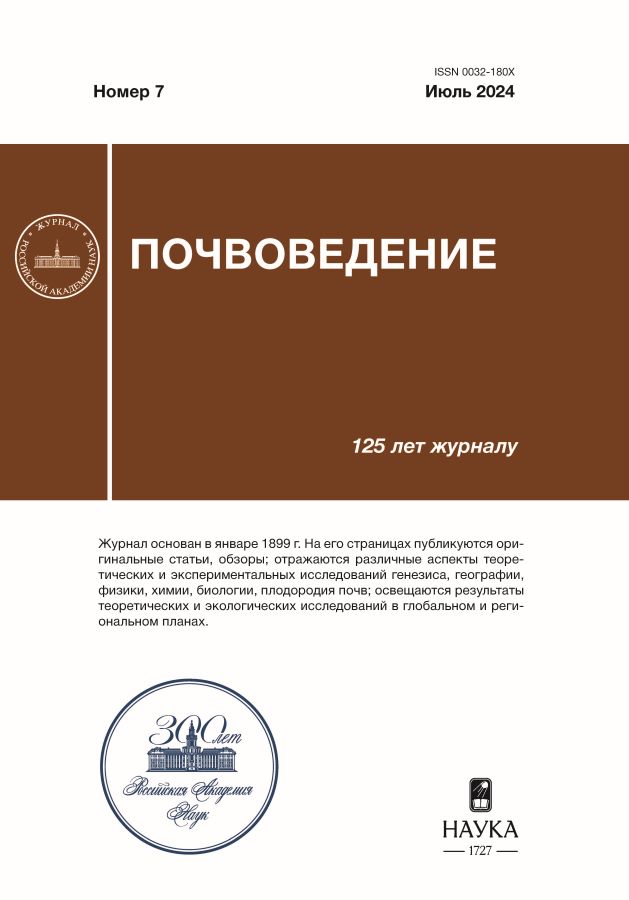The Effect of Soil Buffering Capacity on the Transformation of Lead and Cadmium Compounds
- Authors: Burachevskaya M.V.1, Minkina T.M.1, Mandzhieva S.S.1, Bauer T.V.1, Kirichkov M.V.1, Nevidomskaya D.G.1, Zamulina I.V.1
-
Affiliations:
- Southern Federal University
- Issue: No 7 (2024)
- Pages: 936-949
- Section: SOIL CHEMISTRY
- URL: https://kld-journal.fedlab.ru/0032-180X/article/view/666613
- DOI: https://doi.org/10.31857/S0032180X24070029
- EDN: https://elibrary.ru/XVKUGN
- ID: 666613
Cite item
Abstract
The aim of the work is to study the transformation of priority pollutants Lead (Pb) and Cadmium (Cd) in soils with different buffering capacities and pollution levels. The object of the study is the southern Chernozem (Haplic Chernozem) carbonate-heavy loamy soil, selected from a virgin site in the Rostov region, with a layer of 0 –20 cm. Lead and Cd nitrates were introduced separately in doses of 2, 5, and 10 approximately permissible concentrations (APC) of metal (for Pb 130 mg/kg and for Cd 2 mg/kg) into soil samples of the model experiment containing quartz sand in the ratios 1:0.25, 1:0.5, and 1:0.75 from the mass of the soil. The assessment of the buffer capacity of soils in relation to Pb and Cd was carried out according to the method of V.B. Ilyin (1995), based on the content of physical clay, humus, carbonates, R2O3, and pH. The ability of soils to firmly bound Pb and Cd was studied based on the results of the fractional group composition of metals using a combined fractionation method. In uncontaminated southern heavy loamy Chernozem, the buffering capacity of soils in relation to Pb and Cd is high and is ensured by the strong retention of metals by silicates and clay minerals (50 –64% of the sum of fractions). Dilution of the initial soil with quartz sand reduces its buffering capacity from high to medium and low. When soil is polluted, organic matter plays the most active role in the interaction with Pb, as in the case of Cd–Fe–Mn oxides. With a decrease in soil buffering and an increase in pollution, the group of loosely bound compounds increases by 6 –54%, mainly due to complex compounds in the case of Pb and exchangeable and specifically sorbed with Fe–Mn oxides in the case of Cd. At a dose of 10 APC of Pb, the gradation of soil buffering changes from low to very low. The data obtained are important for the prediction and normalization of soil pollution with various physico-chemical properties.
Full Text
##article.viewOnOriginalSite##About the authors
M. V. Burachevskaya
Southern Federal University
Author for correspondence.
Email: mburachevskaya@sfedu.ru
Russian Federation, Rostov-on-Don
T. M. Minkina
Southern Federal University
Email: mburachevskaya@sfedu.ru
Russian Federation, Rostov-on-Don
S. S. Mandzhieva
Southern Federal University
Email: mburachevskaya@sfedu.ru
Russian Federation, Rostov-on-Don
T. V. Bauer
Southern Federal University
Email: mburachevskaya@sfedu.ru
Russian Federation, Rostov-on-Don
M. V. Kirichkov
Southern Federal University
Email: mburachevskaya@sfedu.ru
Russian Federation, Rostov-on-Don
D. G. Nevidomskaya
Southern Federal University
Email: mburachevskaya@sfedu.ru
Russian Federation, Rostov-on-Don
I. V. Zamulina
Southern Federal University
Email: mburachevskaya@sfedu.ru
Russian Federation, Rostov-on-Don
References
Supplementary files














